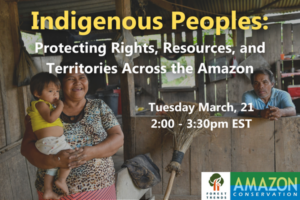
“The Shuar Arutam will always fight because that is our right. […] To whoever wants to silence our voice, behind me are other generations, our children’s children, and all the indigenous peoples of the world who will keep on fighting against those who want to threaten us and stop our communities.”
– Marco Martinez, Territorial Executive of the Shuar Arutam Indigenous Community of Ecuador
On March 21, Amazon Conservation co-hosted a webinar with partner Forest Trends about “Indigenous Peoples: Protecting Rights, Resources, and Territories across the Amazon,” where we heard directly from indigenous leaders and conservation experts from Brazil, Bolivia, Peru, Ecuador, and the US to explore how indigenous peoples are employing technology to support their territorial governance and leveraging the key role they play for climate and conservation.
- Local Experiences in Protecting Indigenous Territories
- Driving Climate Finance to Indigenous Peoples and Local Communities through the Territorial Governance Facility
- Technology and Governance
- Investing in the Defense of Indigenous Territories
See the full agenda here or view the full webinar recording here in speakers’ original presentation language (English subtitles to come).
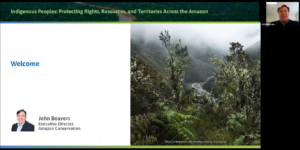
John Beavers, the Executive Director of Amazon Conservation, opened the session and provided context of the importance of protecting Indigenous rights and territories, not just for Indigenous Peoples, but also for the greater protection of the Amazon and planet. “Protecting indigenous rights, resources and territories protects the Amazon’s forests and waters and all of the rest that this implies – the protection of vital ecosystem services including their role in climate adaptation and resilience and carbon storage, biodiversity conservation, as well as providing a foundation for their countries’ and regional economies.”
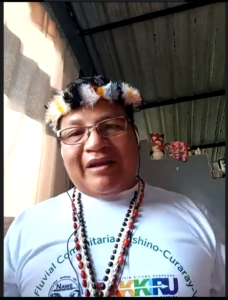
Gilberto Mincaye Nenquimo, the President of the Waorani Nationality of Ecuador, provided Opening Remarks, highlighting a number of the challenges that indigenous communities such as the Waorani face in having the tools and resources to protect and govern their territories as well as the important role that NGOs and international support play due to the limitations of the federal government in having the interest and capacity to provide the resources needed to adequate monitor their territory, which covers 1,986,000 acres across three different provinces in the Ecuadorian Amazon. “The end goal is that the territory is completely controlled and monitored by the Waorani community and that the people learn how to manage whatever they need. And before we couldn’t do that; we didn’t have any tools. So now we do have tools and things that we can use to improve the condition and the support from other NGOs is super important to us.”
Setting the stage for the rest of the speakers, Gilberto highlighted the pivotal challenge that his community, like many others, currently face as they are seeing the need to “defend the last forests as many have already been destroyed, and now our rivers, our landscape are being damaged and there are less spaces to protect.” Given the dire need and desire to take action in the absence of state support, they want the international community to know: “We don’t have that expertise but we do have the ability to learn.”
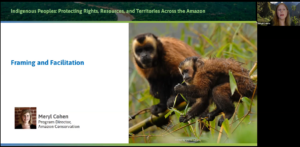 The event’s moderator Meryl Cohen, Amazon Conservation’s Programs Director, reminded viewers of the heightened dangers many of the local communities face in protecting their territories and resources, “as we see increasing threats of violence from illegal actors on a regular basis, and the number of indigenous activists killed each year continues to increase with impunity.” Meryl also indicated several determining factors in indigenous peoples’ ability to successfully protect their lands, including tenure rights; access to technology and training to put that technology into action; right to self determination; cooperation and inclusive decision making; and the basic recognition of inherent rights of indigenous peoples. To introduce the first panel on Local Experiences in Protecting Indigenous Territories, Meryl noted, “Drawing on diverse knowledges and cultural values, meaningful participation and inclusive engagement processes—including indigenous knowledge, local knowledge, and scientific knowledge—facilitates climate resilient development, builds capacity and allows locally appropriate and socially acceptable solutions.”
The event’s moderator Meryl Cohen, Amazon Conservation’s Programs Director, reminded viewers of the heightened dangers many of the local communities face in protecting their territories and resources, “as we see increasing threats of violence from illegal actors on a regular basis, and the number of indigenous activists killed each year continues to increase with impunity.” Meryl also indicated several determining factors in indigenous peoples’ ability to successfully protect their lands, including tenure rights; access to technology and training to put that technology into action; right to self determination; cooperation and inclusive decision making; and the basic recognition of inherent rights of indigenous peoples. To introduce the first panel on Local Experiences in Protecting Indigenous Territories, Meryl noted, “Drawing on diverse knowledges and cultural values, meaningful participation and inclusive engagement processes—including indigenous knowledge, local knowledge, and scientific knowledge—facilitates climate resilient development, builds capacity and allows locally appropriate and socially acceptable solutions.”
Local Experiences in Protecting Indigenous Territories
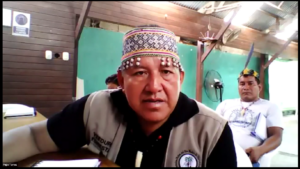 Kicking off the panel on Local Experiences, we heard from representatives from FENAMAD (the Native Federation of the Madre de Dios River region) in Peru. Alfredo Vargas, newly-elected President of FENAMAD, Julio Cusirichi Palacios, former FENAMAD President, and Pepe Torres, who coordinates FENAMAD’s Community Monitoring and Oversight Program (called Programa de Veeduría in Spanish), describe the difficulties their Federation has faced with getting support from the government to protect their territories in the Madre de Dios region, where illegal mining is a major threat to the Amazon and Indigenous communities living there. Julio explains, “the state gives support to third parties that threaten our territories with invasions, incursions, and concessions, and instead of helping, … the state actually adds to the vulnerability of these communities.” Thanks to the support of partners like the Norwegian Agency for Development Cooperation (Norad) and Amazon Conservation, however, FENAMAD has been able to develop a community monitoring program with the technical capacity and system in place to identify incursions on their territory, produce the coordinates and satellite imagery to submit formal complaints, and utilize the state’s legal system to pressure the government to enforce the rule of law and address illegal mining in the region.
Kicking off the panel on Local Experiences, we heard from representatives from FENAMAD (the Native Federation of the Madre de Dios River region) in Peru. Alfredo Vargas, newly-elected President of FENAMAD, Julio Cusirichi Palacios, former FENAMAD President, and Pepe Torres, who coordinates FENAMAD’s Community Monitoring and Oversight Program (called Programa de Veeduría in Spanish), describe the difficulties their Federation has faced with getting support from the government to protect their territories in the Madre de Dios region, where illegal mining is a major threat to the Amazon and Indigenous communities living there. Julio explains, “the state gives support to third parties that threaten our territories with invasions, incursions, and concessions, and instead of helping, … the state actually adds to the vulnerability of these communities.” Thanks to the support of partners like the Norwegian Agency for Development Cooperation (Norad) and Amazon Conservation, however, FENAMAD has been able to develop a community monitoring program with the technical capacity and system in place to identify incursions on their territory, produce the coordinates and satellite imagery to submit formal complaints, and utilize the state’s legal system to pressure the government to enforce the rule of law and address illegal mining in the region.
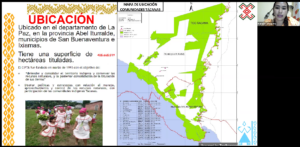 The next speaker Kareen Cartagena, the Monitoring Lead for the Tacana 1 territory in northeastern Bolivia who works with CIPTA, the Tacana Community Indigenous Council, discussed the challenges the Tacana’s 22 communities face as they are still fighting for legal titling of their territory that has yet to be formalized by the government and as a result, their land has been subject to illegal mining, hunting and fishing as well as agricultural encroachment, and many of the communities don’t have access to basic services like water, electricity, or a health center. With the support of partners like the Moore Foundation and Amazon Conservation, the Tacana have been developing their own monitoring systems, which “is not just monitoring, it is also strengthening the capacity and the abilities of Indigenous people,” but Kareen emphasized that they “need to add more efforts to this fight to be able to preserve our way of life, which is peaceful coexistence.”
The next speaker Kareen Cartagena, the Monitoring Lead for the Tacana 1 territory in northeastern Bolivia who works with CIPTA, the Tacana Community Indigenous Council, discussed the challenges the Tacana’s 22 communities face as they are still fighting for legal titling of their territory that has yet to be formalized by the government and as a result, their land has been subject to illegal mining, hunting and fishing as well as agricultural encroachment, and many of the communities don’t have access to basic services like water, electricity, or a health center. With the support of partners like the Moore Foundation and Amazon Conservation, the Tacana have been developing their own monitoring systems, which “is not just monitoring, it is also strengthening the capacity and the abilities of Indigenous people,” but Kareen emphasized that they “need to add more efforts to this fight to be able to preserve our way of life, which is peaceful coexistence.”
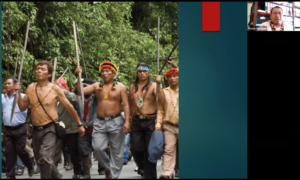 Marco Martinez, the Territorial Executive of the Shuar Arutam Indigenous Community (PSHA) in Ecuador, spoke next about the Shuar Arutam’s ongoing fight against large-scale mining, which the government, despite signing agreements and commitments to conservation, has unfortunately allowed to expand and in their wake destroyed the beaches, rivers, and communities in the region. In response, the Shuar Arutam have been working with Fundación EcoCiencia, a new in-country partner of Amazon Conservation, to monitor their territory on their own, determined to halt the threats to the land and resources: “We have to be the ones who respond to these issues as the original people that lived here. We have to be part of how to stop this atrocity that is occurring and to safeguard the future or else our generation will be exterminated. I say so because the government doesn’t stop, the state doesn’t stop.”
Marco Martinez, the Territorial Executive of the Shuar Arutam Indigenous Community (PSHA) in Ecuador, spoke next about the Shuar Arutam’s ongoing fight against large-scale mining, which the government, despite signing agreements and commitments to conservation, has unfortunately allowed to expand and in their wake destroyed the beaches, rivers, and communities in the region. In response, the Shuar Arutam have been working with Fundación EcoCiencia, a new in-country partner of Amazon Conservation, to monitor their territory on their own, determined to halt the threats to the land and resources: “We have to be the ones who respond to these issues as the original people that lived here. We have to be part of how to stop this atrocity that is occurring and to safeguard the future or else our generation will be exterminated. I say so because the government doesn’t stop, the state doesn’t stop.”
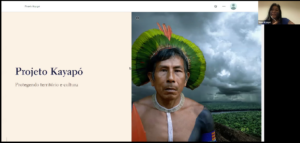 To wrap up this first section about Local Experiences, Maial Kaiapó, who is a community member of the Kayapó Indigenous Community in Brazil, and Igor Ferreira, GIS Director of the Kayapó Project, who shared how the Kayapó have successfully established a Protected Forest Association so that the Kayapó could use technology and MAAP satellite imagery to protect their territory through partnership with Amazon Conservation’s Monitoring of the Andean Amazon Project (MAAP). Located in the infamous arc of deforestation where 80% of the deforestation in the Brazilian Amazon takes place, the Kayapó are “at the center of the conflict that pits indigenous peoples against the illegal loggers, miners, the hydroelectric companies, and so we are being impacted by different forms of destruction of our environment and of deforestation.” When, as Maial and Igor explained, “the prior administration was bent on destroying our rights and our lands,” they are finding empowerment by continuing “to resist and to fight to fulfill our very important role of monitoring, oversight, collecting information all for the purpose of continuing to protect our people, our communities, villages, and to gather information, the evidence necessary with which to take to the courts to bring lawsuits against the state if necessary.” With each lawsuit success, they are advancing the protection of their territory and conservation of the forest for all indigenous peoples in the Amazon.
To wrap up this first section about Local Experiences, Maial Kaiapó, who is a community member of the Kayapó Indigenous Community in Brazil, and Igor Ferreira, GIS Director of the Kayapó Project, who shared how the Kayapó have successfully established a Protected Forest Association so that the Kayapó could use technology and MAAP satellite imagery to protect their territory through partnership with Amazon Conservation’s Monitoring of the Andean Amazon Project (MAAP). Located in the infamous arc of deforestation where 80% of the deforestation in the Brazilian Amazon takes place, the Kayapó are “at the center of the conflict that pits indigenous peoples against the illegal loggers, miners, the hydroelectric companies, and so we are being impacted by different forms of destruction of our environment and of deforestation.” When, as Maial and Igor explained, “the prior administration was bent on destroying our rights and our lands,” they are finding empowerment by continuing “to resist and to fight to fulfill our very important role of monitoring, oversight, collecting information all for the purpose of continuing to protect our people, our communities, villages, and to gather information, the evidence necessary with which to take to the courts to bring lawsuits against the state if necessary.” With each lawsuit success, they are advancing the protection of their territory and conservation of the forest for all indigenous peoples in the Amazon.
Driving Climate Finance to Indigenous Peoples and Local Communities through the Territorial Governance Facility
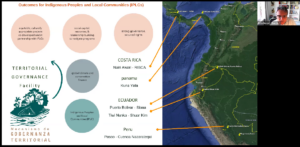
The following section looked at the role of finance as it relates to indigenous territories and territorial management. First to speak on the subject was Beto Borges, the Director of Forest Trends’ Communities and Territorial Governance Initiative, who co-hosted this webinar. Beto acknowledged the important fight the indigenous leaders are facing and the life-threatening challenges to being able to protect and govern indigenous territories and conserve their resources. Unfortunately, less than 1% of climate funding in the international community actually reaches communities directly, so Forest Trends launched the Territorial Governance Facility this year with the objective of “strengthening the territorial governance of indigenous peoples and local communities” by providing culturally-appropriate technical and financial assistance needed so that they can engage in conservation and climate finance. Forest Trends expects that the Territorial Governance Facility will help close the gap in aid directly received by local communities.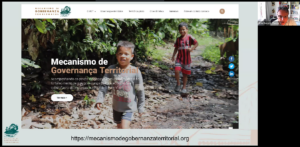
“We’ve heard from our indigenous leaders about the importance and the challenges that they’re having in relation to protecting their territories and promoting the good governance of their territories. But in order to do that, it’s important to drive climate and conservation finance directly to the hands of these indigenous leaders who are fighting with their own lives to protect their territories.”
– Beto Borges, Director of Communities and Territorial Governance Initiative, Forest Trends
Technology and Governance
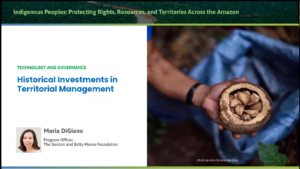
For the webinar’s next section on the role of technology and governance in protecting Indigenous territories, Maria DiGiano, the Program Officer for the Andes-Amazon Initiative of The Gordon and Betty Moore Foundation, provided a philanthropic perspective on lessons learned from the Moore Foundation’s 20 years of investment in conserving the Amazon biome. Maria described how the Moore Foundation has been following the important contributions of Indigenous territories, community monitoring, and the impacts of the recognition of local and Indigenous rights for conservation and has been reworking how they invest in biodiversity and ecosystem conservation. As heard from the panelists in this webinar, creating protected areas is not enough to conserve these forests and mitigate threats. Maria spoke about how tools for territorial management and protection “can also serve as pathways to recognizing other rights, such as self-determination and empowering communities to advocate for rights to food security, a safe environment, [and] health” and how “investments in technology and monitoring allow territorial managers to respond in real time to threats, and helps us understand the contributions of these territories to mitigating those threats and promoting conservation outcomes.” Based on these learnings, the Moore Foundation is also moving forward with investments in systemic changes by supporting governance, including efforts to make legal frameworks stronger, make sure legal frameworks are actually implemented and enforced, and ensuring people at all levels have the capacity to engage effectively in securing those rights.
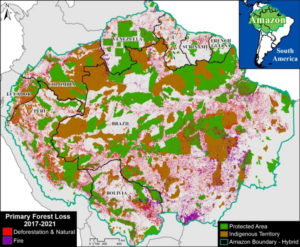 We next heard from Amazon Conservation’s MAAP Director, Matt Finer. Matt presented the about how real time monitoring and MAAP data continues to support key evidence of the importance of Indigenous territories for conservation across the Amazon, as published in the recently published MAAP #183 report on Protected Areas and Indigenous Territories Effective Against Deforestation Across Amazon. In this report, Amazon Conservation evaluated the impact of two of the most important land-use categories: protected areas and indigenous territories. Our study looked across all nine countries of the Amazon biome, a vast area of 2.18 billion acres. We documented the loss of 27 million acres of primary forests across all nine countries of the Amazon biome between 2017 and 2021. For the major land use categories, we identified that 11% of the forest loss occurred in both protected areas and indigenous territories, while the remaining 78% occurred outside these designations. This shows that protected areas and indigenous territories are vital tools to keep deforestation and fires at bay.
We next heard from Amazon Conservation’s MAAP Director, Matt Finer. Matt presented the about how real time monitoring and MAAP data continues to support key evidence of the importance of Indigenous territories for conservation across the Amazon, as published in the recently published MAAP #183 report on Protected Areas and Indigenous Territories Effective Against Deforestation Across Amazon. In this report, Amazon Conservation evaluated the impact of two of the most important land-use categories: protected areas and indigenous territories. Our study looked across all nine countries of the Amazon biome, a vast area of 2.18 billion acres. We documented the loss of 27 million acres of primary forests across all nine countries of the Amazon biome between 2017 and 2021. For the major land use categories, we identified that 11% of the forest loss occurred in both protected areas and indigenous territories, while the remaining 78% occurred outside these designations. This shows that protected areas and indigenous territories are vital tools to keep deforestation and fires at bay.
To close this section about Governance, we heard from Humberto Balbuena, the Environmental Policy and Governance Director of Conservación Amazónica – ACCA, Amazon Conservation’s sister organization based in Peru, who shared how important good governance and effectively applying the law are to protect indigenous territories and reach conservation goals. While creating a legal framework is relatively easy, Humberto explained, but whether the framework is realistic, well-articulated, effective, and fair is a different matter. Furthermore, the application of the law depends on government institutions understanding how to apply the law, transparency, strengthening capabilities of its agents and actors, anti-corruption and trust, and working to engage with actors and civil society in cooperative efforts to find what gaps may exist and build trust. 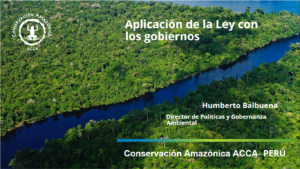
In the case of Peru, Conservación Amazónica – ACCA has been working with local communities and government to implement monitoring, especially satellite monitoring, “to make better informed and real time decisions.” Humberto emphasized: “Environmental Justice shouldn’t be an ideal, but it should be a tangible reality that we are able to identify and exemplify… The indigenous communities are agents of change with an important role in the conservation of the Amazon.”
Investing in the Defense of Indigenous Territories
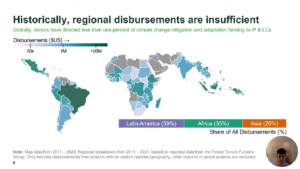 In the webinar’s final section, Michael Owen from Indufor North America shared recent research about recent finance trends supporting Indigenous Peoples and Local Communities in Latin America, highlighting that despite increased interest, new donors, and new funding agreements, funding for Indigenous Peoples and Local Communities did not changed significantly from 2017-2020 and only started to notably increase in 2021 thanks to growing interest from private funders. Unfortunately, Michael stated, “A disproportionate share of this finance that includes Indigenous Peoples and Local Communities has been in the forest management, conservation, and biodiversity space. Rights or territorial mapping has not been the core priority for the bulk of this funding.”
In the webinar’s final section, Michael Owen from Indufor North America shared recent research about recent finance trends supporting Indigenous Peoples and Local Communities in Latin America, highlighting that despite increased interest, new donors, and new funding agreements, funding for Indigenous Peoples and Local Communities did not changed significantly from 2017-2020 and only started to notably increase in 2021 thanks to growing interest from private funders. Unfortunately, Michael stated, “A disproportionate share of this finance that includes Indigenous Peoples and Local Communities has been in the forest management, conservation, and biodiversity space. Rights or territorial mapping has not been the core priority for the bulk of this funding.”
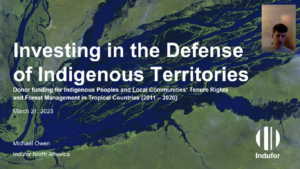
Click to see Michael Owen’s full presentation.
An important takeaway from this research, Michael noted, is that on the ground we are seeing that national and local NGOs have been the single largest source of direct financing for Indigenous Peoples Organizations (IPOs) in Latin America. Although they only received 26% of total funding disbursements, they were responsible for 41% of all disbursements to IPOs, while International Organizations have only included IPOs in 25% of their disbursements. Michael concluded, “Our data and research…shows that partnering with national and local NGOs creates lasting, strong relationships that enable real, potentially direct, change.”
Closing Remarks
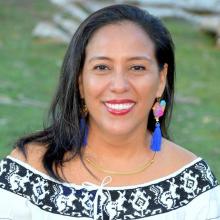
To close the session, Anita Tzec, who is Maya Yucatec from Belize and the Senior Program Manager on Indigenous Peoples & Conservation in the IUCN’s Human Rights in Conservation Team, shared some of her main takeaways from the webinar. Anita summarized the session’s key themes, which include that 1) indigenous territories must be recognized as high value territories of life, not only for indigenous peoples but for all of humanity and biodiversity; 2) Indigenous peoples must define inclusive financing investment priorities: investments in conservation, climate change, biodiversity must come from the ground; 3) Indigenous peoples must be decision makers in the governance of inclusive financing at all levels, from the local to global and global to local; and 4) national governments have a key responsibility in scaling up inclusive financing for indigenous peoples and recognizing them as rights holders.
Anita closed the webinar with a call for national governments, the environmental donor community, and allies to stand up for Mother Earth and Indigenous Peoples, and with a final inspiring note from the Popol Vuh, the sacred book of the Maya:
“Que todos se levanten, que nadie se quede atrás, que nos seamos ni uno ni dos de nosotros, sino todos.”
[“That we all stand up, that nobody is left behind, that it is not just one or two of us, but all of us.”]
– Popol Vuh, sacred book of the Maya
Thank you to all our participants and panelists for attending our session. Watch the webinar recording here (English subtitles will be added shortly). To see what other upcoming events we have, please visit amazonconservation.org/events.
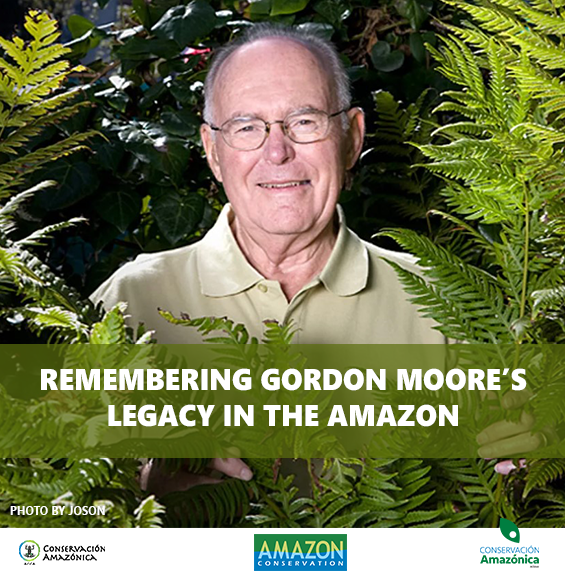

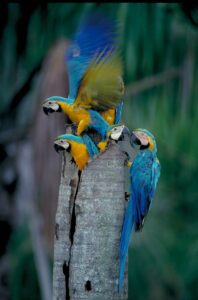 Here are 4 quick and easy ways you can Invest in Our Future and the Amazon this April:
Here are 4 quick and easy ways you can Invest in Our Future and the Amazon this April: 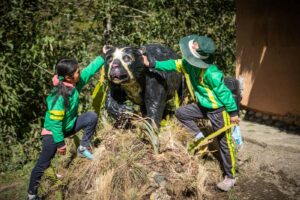 3. Learn the different ways to
3. Learn the different ways to 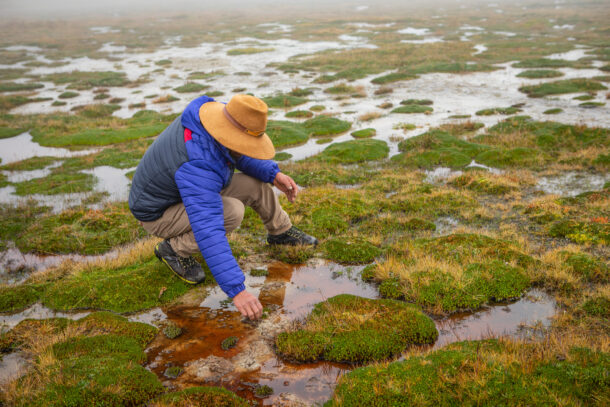 “Learning to restore our
“Learning to restore our 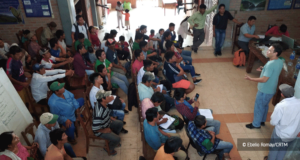



 The event’s moderator Meryl Cohen, Amazon Conservation’s Programs Director, reminded viewers of the heightened dangers many of the local communities face in protecting their territories and resources, “as we see increasing threats of violence from illegal actors on a regular basis, and the number of indigenous activists killed each year continues to increase with impunity.” Meryl also indicated several determining factors in indigenous peoples’ ability to successfully protect their lands, including tenure rights; access to technology and training to put that technology into action; right to self determination; cooperation and inclusive decision making; and the basic recognition of inherent rights of indigenous peoples. To introduce the first panel on Local Experiences in Protecting Indigenous Territories, Meryl noted, “Drawing on diverse knowledges and cultural values, meaningful participation and inclusive engagement processes—including indigenous knowledge, local knowledge, and scientific knowledge—facilitates climate resilient development, builds capacity and allows locally appropriate and socially acceptable solutions.”
The event’s moderator Meryl Cohen, Amazon Conservation’s Programs Director, reminded viewers of the heightened dangers many of the local communities face in protecting their territories and resources, “as we see increasing threats of violence from illegal actors on a regular basis, and the number of indigenous activists killed each year continues to increase with impunity.” Meryl also indicated several determining factors in indigenous peoples’ ability to successfully protect their lands, including tenure rights; access to technology and training to put that technology into action; right to self determination; cooperation and inclusive decision making; and the basic recognition of inherent rights of indigenous peoples. To introduce the first panel on Local Experiences in Protecting Indigenous Territories, Meryl noted, “Drawing on diverse knowledges and cultural values, meaningful participation and inclusive engagement processes—including indigenous knowledge, local knowledge, and scientific knowledge—facilitates climate resilient development, builds capacity and allows locally appropriate and socially acceptable solutions.”
 The next speaker Kareen Cartagena, the Monitoring Lead for the Tacana 1 territory in northeastern Bolivia who works with CIPTA, the Tacana Community Indigenous Council, discussed the challenges the Tacana’s 22 communities face as they are still fighting for legal titling of their territory that has yet to be formalized by the government and as a result, their land has been subject to illegal mining, hunting and fishing as well as agricultural encroachment, and many of the communities don’t have access to basic services like water, electricity, or a health center. With the support of partners like the Moore Foundation and Amazon Conservation, the Tacana have been developing their own monitoring systems, which “is not just monitoring, it is also strengthening the capacity and the abilities of Indigenous people,” but Kareen emphasized that they “need to add more efforts to this fight to be able to preserve our way of life, which is peaceful coexistence.”
The next speaker Kareen Cartagena, the Monitoring Lead for the Tacana 1 territory in northeastern Bolivia who works with CIPTA, the Tacana Community Indigenous Council, discussed the challenges the Tacana’s 22 communities face as they are still fighting for legal titling of their territory that has yet to be formalized by the government and as a result, their land has been subject to illegal mining, hunting and fishing as well as agricultural encroachment, and many of the communities don’t have access to basic services like water, electricity, or a health center. With the support of partners like the Moore Foundation and Amazon Conservation, the Tacana have been developing their own monitoring systems, which “is not just monitoring, it is also strengthening the capacity and the abilities of Indigenous people,” but Kareen emphasized that they “need to add more efforts to this fight to be able to preserve our way of life, which is peaceful coexistence.” Marco Martinez, the Territorial Executive of the Shuar Arutam Indigenous Community (PSHA) in Ecuador, spoke next about the Shuar Arutam’s ongoing fight against large-scale mining, which the government, despite signing agreements and commitments to conservation, has unfortunately allowed to expand and in their wake destroyed the beaches, rivers, and communities in the region. In response, the Shuar Arutam have been working with Fundación EcoCiencia, a new in-country partner of Amazon Conservation, to monitor their territory on their own, determined to halt the threats to the land and resources: “We have to be the ones who respond to these issues as the original people that lived here. We have to be part of how to stop this atrocity that is occurring and to safeguard the future or else our generation will be exterminated. I say so because the government doesn’t stop, the state doesn’t stop.”
Marco Martinez, the Territorial Executive of the Shuar Arutam Indigenous Community (PSHA) in Ecuador, spoke next about the Shuar Arutam’s ongoing fight against large-scale mining, which the government, despite signing agreements and commitments to conservation, has unfortunately allowed to expand and in their wake destroyed the beaches, rivers, and communities in the region. In response, the Shuar Arutam have been working with Fundación EcoCiencia, a new in-country partner of Amazon Conservation, to monitor their territory on their own, determined to halt the threats to the land and resources: “We have to be the ones who respond to these issues as the original people that lived here. We have to be part of how to stop this atrocity that is occurring and to safeguard the future or else our generation will be exterminated. I say so because the government doesn’t stop, the state doesn’t stop.” To wrap up this first section about Local Experiences, Maial Kaiapó, who is a community member of the Kayapó Indigenous Community in Brazil, and Igor Ferreira, GIS Director of the Kayapó Project, who shared how the Kayapó have successfully established a Protected Forest Association so that the Kayapó could use technology and MAAP satellite imagery to protect their territory through partnership with Amazon Conservation’s
To wrap up this first section about Local Experiences, Maial Kaiapó, who is a community member of the Kayapó Indigenous Community in Brazil, and Igor Ferreira, GIS Director of the Kayapó Project, who shared how the Kayapó have successfully established a Protected Forest Association so that the Kayapó could use technology and MAAP satellite imagery to protect their territory through partnership with Amazon Conservation’s 


 We next heard from Amazon Conservation’s MAAP Director, Matt Finer. Matt presented the about how real time monitoring and MAAP data continues to support key evidence of the importance of Indigenous territories for conservation across the Amazon, as published in the recently published MAAP #183 report on
We next heard from Amazon Conservation’s MAAP Director, Matt Finer. Matt presented the about how real time monitoring and MAAP data continues to support key evidence of the importance of Indigenous territories for conservation across the Amazon, as published in the recently published MAAP #183 report on 
 In the webinar’s final section, Michael Owen from Indufor North America shared recent research about recent finance trends supporting Indigenous Peoples and Local Communities in Latin America, highlighting that despite increased interest, new donors, and new funding agreements, funding for Indigenous Peoples and Local Communities did not changed significantly from 2017-2020 and only started to notably increase in 2021 thanks to growing interest from private funders. Unfortunately, Michael stated, “A disproportionate share of this finance that includes Indigenous Peoples and Local Communities has been in the forest management, conservation, and biodiversity space. Rights or territorial mapping has not been the core priority for the bulk of this funding.”
In the webinar’s final section, Michael Owen from Indufor North America shared recent research about recent finance trends supporting Indigenous Peoples and Local Communities in Latin America, highlighting that despite increased interest, new donors, and new funding agreements, funding for Indigenous Peoples and Local Communities did not changed significantly from 2017-2020 and only started to notably increase in 2021 thanks to growing interest from private funders. Unfortunately, Michael stated, “A disproportionate share of this finance that includes Indigenous Peoples and Local Communities has been in the forest management, conservation, and biodiversity space. Rights or territorial mapping has not been the core priority for the bulk of this funding.”

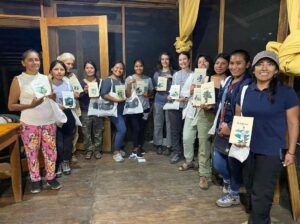
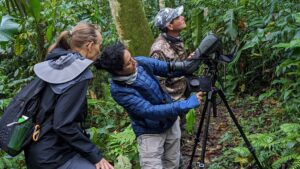
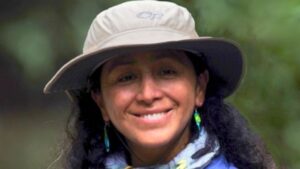
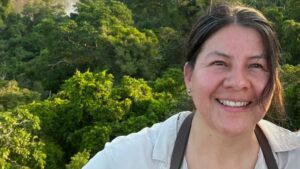
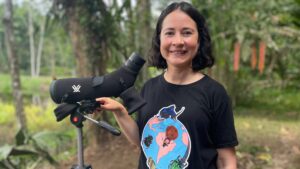
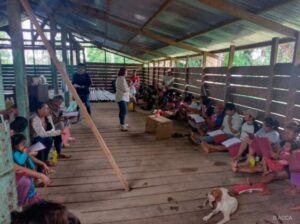
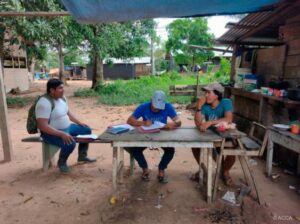
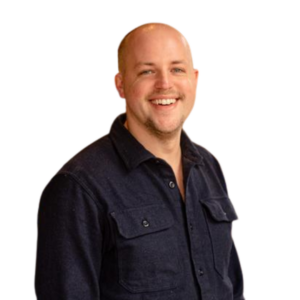
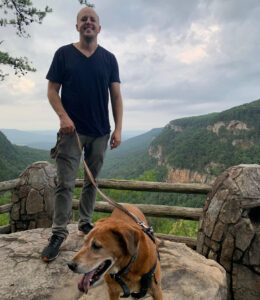
